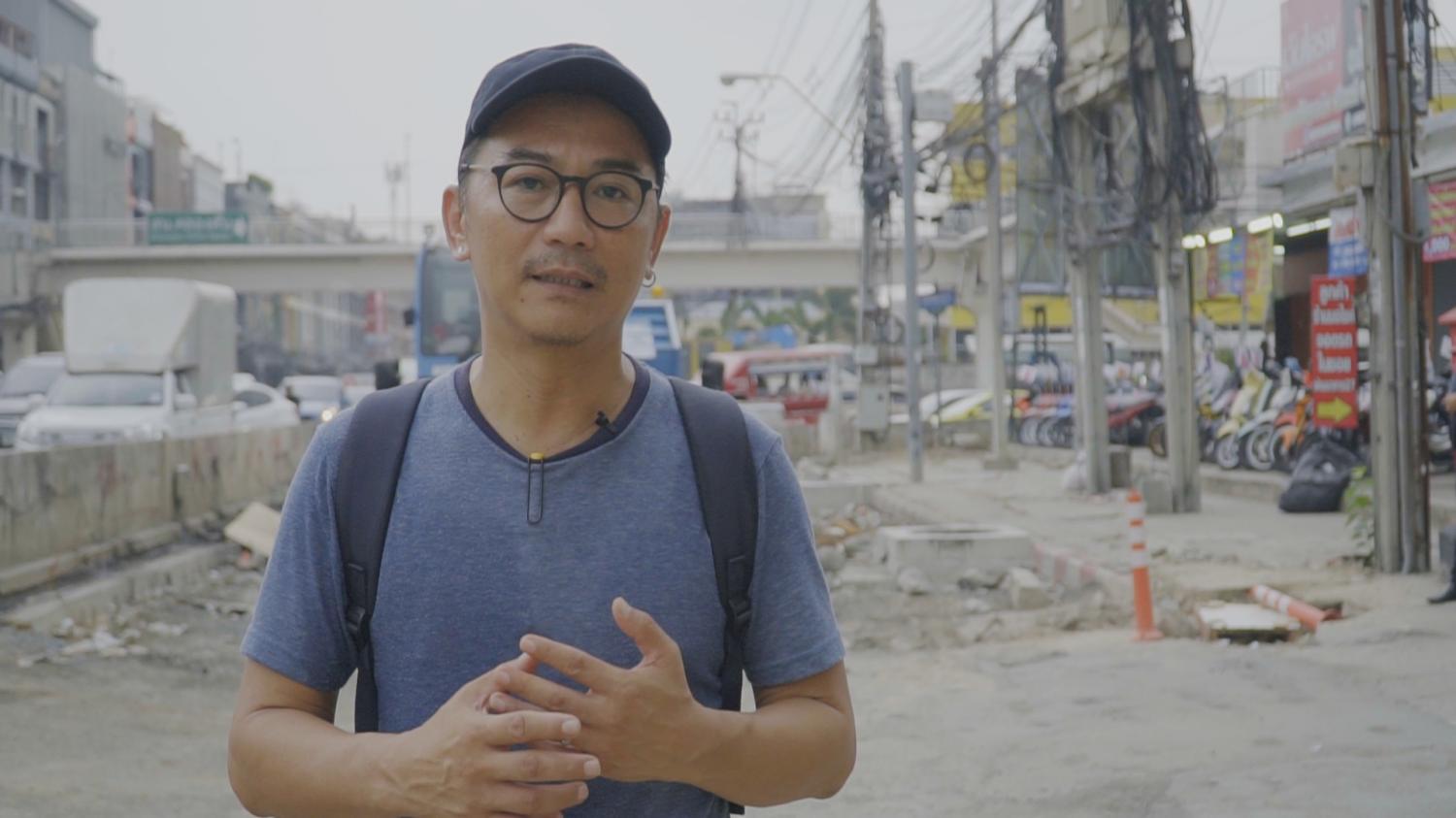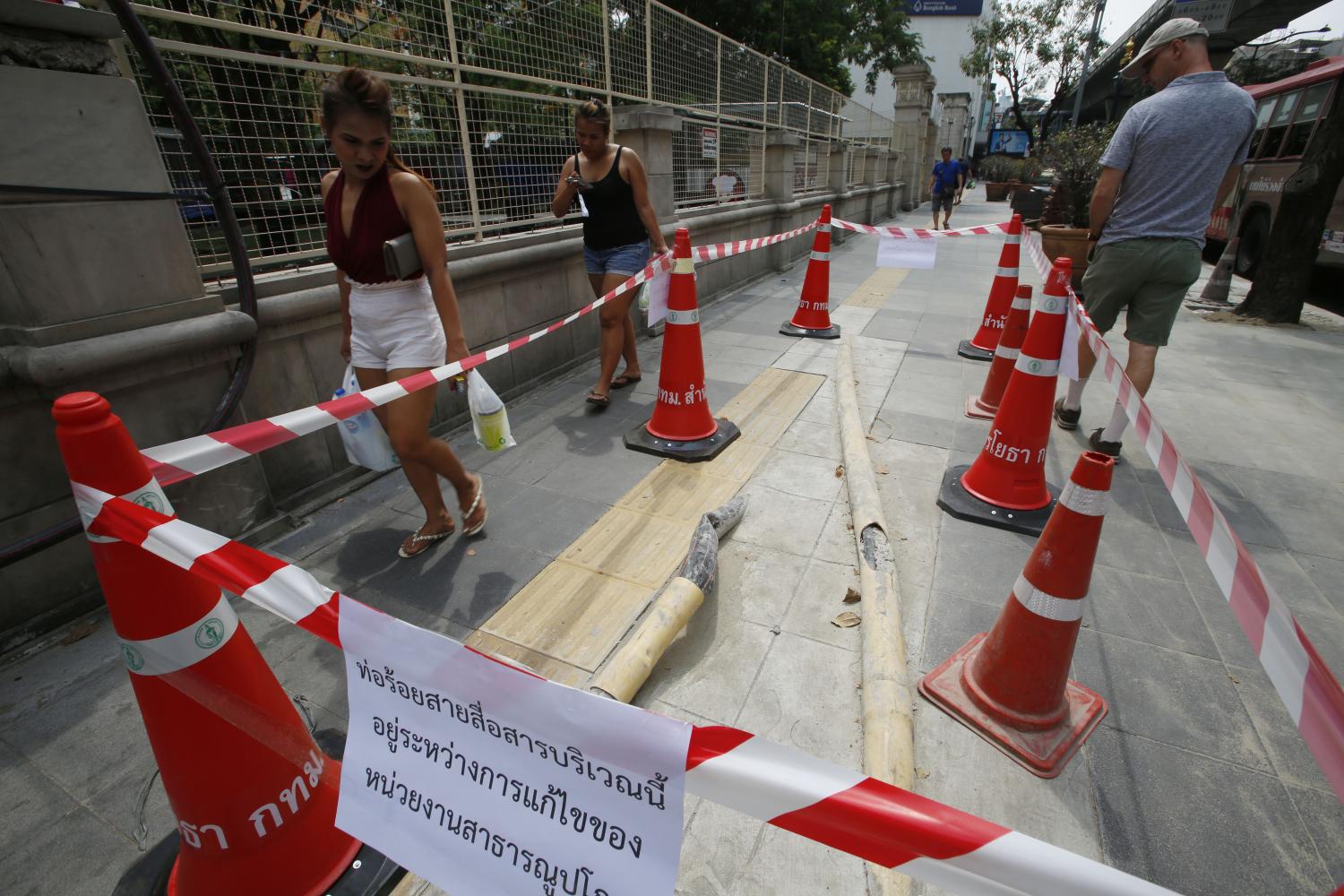Bangkok is the largest city in the country. About 10 million people live and work within its 1,569 square kilometre (km²) boundaries. Of that land, 113.2km² is road space and 22.55km² is pavement area for pedestrians, according to the Bangkok Metropolitan Administration (BMA). Despite the small fraction of space they occupy, the footpaths of Bangkok are known for their state of disrepair.
The BMA claims it has spent significant sums to fix the problem, yet it still persists.
According to the BMA's Department of Public Works, City Hall already spends at least 500 million baht per year just on repairs and maintenance of the footpaths across Bangkok's 50 districts.
Nevertheless, despite its best efforts, pedestrians remain unhappy.
People complain about potholes, obstructions, rubbish and seemingly endless repair work, not to mention the tree felling which they have blamed for debeautifying areas and removing shade.

Documenting the problem: Mr Sittan often visits problematic pavement sites. His Facebook page 'The Sidewalk: Loek Kwang Karng Tang Thao' has 46,000 followers.
Among the loudest voices on this matter is a Facebook page named "The Sidewalk: Loek Kwang Karng Tang Thao" (The Sidewalk: Wide World on Footpaths). Started just a year ago, the page allows city residents to voice their anger and share their experiences about footpaths in the capital. It already has 46,000 followers.
The page, which was created by Sittan "Aung" Chalongtham, a 48-year-old owner of a TV production studio, mostly shows video clips recorded by Mr Sittan of the condition of various local pavements. People also post information about their own experiences.
Here, Mr Sittan tells the Bangkok Post what he feels the BMA should have done, and still fails to do, regarding issues such as street vendors and how to make Bangkok a city that serves pedestrians and not just cars.
Why did you set up this page?
The purpose of The Sidewalk is not to make complaints or report problems. If alerting the BMA to problems could really achieve anything, our experiences with Bangkok's footpaths would already be different.

Blocking the way: An obstruction on the pavement at Pak Klong Talat's famous flower market in Phra Nakhon district. The BMA is rebuilding the pavement to develop it under a landscaping project.
Instead, I created The Sidewalk because I want to share information, prompt debate among the people and point out what could be improved to give people the quality of life they deserve. We need to do this to provoke change. If we do nothing, then there is no hope at all.
Has eliminating street vendors led to a change on the footpaths?
In fact, the problem of sidewalks being blocked is mainly caused by BMA property, not street vendors. Advertising signs and poles, and even telephone and police booths stand right in the middle of many pavements. Recently I shared The Momentum's #SAVESTREETFOODBKK campaign hashtag on The Sidewalk page. Unsurprisingly, I received backlash from my followers saying that I shouldn't support street vendors. Well, I have to explain they are not the real problem.
But don't these street vendor's block pavements for their own commercial interest?
The term "public area" means that it is space for everyone, not only pedestrians. If the pavements are wide enough, there is room for many activities while still allowing people to walk freely. Street vendors might block some parts of the pavement but the root cause of the problem is the size of the pavements themselves.

Lugging it away: Obstructions on pavements are characteristic of Bangkok's pedestrian zones as seen in this file photo near Asok Montri Road.
The Footpath Clean-up Campaign is not the right solution. Unlike many other developed countries, Bangkok has little public space for commercial activities on pavements. Indeed, local "food streets" have traditionally been a source of income and affordable and convenient meals for city residents, not to mention a huge tourist attraction.
However, the BMA has wiped out street vendors and people have lost their livelihoods. The footpath space should be retrieved from the roads, not the street vendors.
What should the BMA do?
The BMA should set clear goals. At the moment, the root cause of the footpath problem is they gave too much space to roads. Therefore, it would be better if they put pedestrians first and aimed to increase the width of pavements to make them more practical for use by a diverse group of people.

Risky opening: Manholes such as the one into which a courier fell last month are a common sight.
Designing public areas requires attention to detail because they involve a variety of users and activities and it takes time and effort to create good design.
But the bottom line is that the design must come from a clear goal and in this respect, the BMA, regrettably has not put pedestrians first. The sorry condition of our pavements speaks volumes!
Can you give us an example?
Look at Ratchayothin intersection. The BMA once announced that every footpath must be 1.5 metres wide. But why does it have to be 1.5 metres wide? Isn't that too small?
Indeed, my research shows the pavement at Ratchayothin intersection used to be about 4 metres wide, but over half of it was cut off to make the road wider to accommodate more cars.
Why is pavement space important?
The quality of life is related to our surroundings and as you may know, living in a city with poor design undoubtedly leads to poor quality of life. This means the residents of Bangkok have to tolerate narrow pavements when they walk and risk serious accidents such as falling down open manholes or spraining ankles due to uneven surfaces.
The problem with Bangkok's pavements is that its city plan is not very people-oriented.

No room to walk: Underneath pavement spaces are utility lines such as telecom cables. These lines require maintenance which leads to digging of pavement space as seen in this photo near Nana BTS station.

